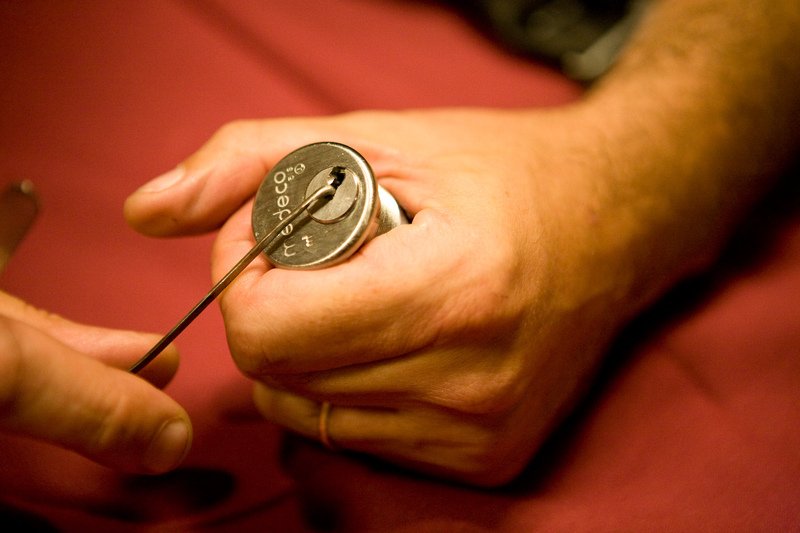Have you ever found yourself knee-deep in a mystery novel, caught up in the thrilling escapades of a master thief skilled in the art of lockpicking? Perhaps you’ve wondered, in that moment of suspense, whether these daring characters possess a heightened understanding of locksmith techniques that enable them to conquer the most formidable of locks with apparent ease. While our curiosity may genuine, let us embark on a journey to uncover the truth behind this seemingly insurmountable skill set. In this article, we will delve into the fascinating realm where lockpickers and locksmiths intersect, exploring how the techniques employed by professional locksmiths can enhance and refine the craft of lockpicking. Get ready to unlock the secrets that lie behind the closed doors of this enigmatic world.
Table of Contents
- Understanding the Fundamentals of Locksmith Techniques
- Analyzing the Interplay of Tension and Pin Manipulation
- Exploring Advanced Methods to Improve Picking Accuracy
- Utilizing Locksmith Training Tools for Skill Enhancement
- Mastering the Art of Lockpicking with Locksmith Techniques
- Q&A
- In Summary

Understanding the Fundamentals of Locksmith Techniques
When it comes to locksmithing, there is a fascinating world of techniques that professionals use to secure your valuables. Let’s delve into some of the fundamental methods that locksmiths employ to keep your locks invulnerable.
- Lock Picking: This technique involves manipulating the internal components of a lock to bypass its security mechanisms. Locksmiths use specialized tools like picks and tension wrenches to carefully manipulate the pins inside a lock, allowing them to turn the cylinder and unlock the door.
- Lock Bumping: Another popular method, lock bumping involves using a specially crafted key-like device called a bump key. When inserted into a lock and tapped gently, the bump key transfers kinetic energy to the pins, causing them to momentarily align and allowing the lock to be opened.
- Key Duplication: A locksmith’s expertise also extends to creating duplicate keys for a wide range of locks. With precise measurements, they can use key-cutting machines to meticulously replicate a key, ensuring it works seamlessly with the corresponding lock.
Understanding the fundamental techniques of locksmithing provides insight into the complexity of this craft. Whether it’s picking a lock or creating duplicate keys, locksmiths have mastered the art of keeping your belongings secure.

Analyzing the Interplay of Tension and Pin Manipulation
When it comes to lock picking and the intricate art of bypassing security mechanisms, understanding the interplay of tension and pin manipulation is essential. The delicate balance between applying the right amount of tension and precisely manipulating the pins is where a skilled locksmith truly shines.
In this fascinating world of lockpicking, tension refers to the gentle pressure exerted on the lock’s core using a tension wrench. This pressure creates a slight rotation in the core, allowing it to interact with the driver pins and key pins inside the lock.
Pin manipulation, on the other hand, revolves around the delicate task of skillfully manipulating the individual pins within the lock. Among the techniques employed are methods like single pin picking, raking, or bumping. Each method has its own set of advantages and intricacies that require careful attention from the locksmith.
Key concepts to understand:
- Tension control: The ability to apply the right amount of tension that allows the pins to bind but not over-tighten, ensuring precise manipulation.
- Feedback interpretation: Developing the sensitivity to interpret the feedback received from the lock, such as slight vibrations or clicks, allowing for strategic adjustments in tension and pin manipulation.
- Pin selection: Identifying the order and sequence in which the pins need to be manipulated, often requiring a combination of instinct and technique.
Meticulously exploring the interplay between tension and pin manipulation is crucial for any aspiring locksmith or lock-picking enthusiast. With unwavering focus and practiced dexterity, one can unlock the secrets concealed within each intricate lock.

Exploring Advanced Methods to Improve Picking Accuracy
In today’s fast-paced world of order fulfillment, picking accuracy plays a crucial role in maintaining customer satisfaction and minimizing returns. As technology continues to advance, so do the methods used to improve accuracy in the picking process. Let’s take a closer look at some of the advanced techniques that can be implemented to enhance the accuracy of pickers and streamline operations.
1. Automated Picking Systems: Investing in automated picking systems can significantly improve accuracy rates. These systems utilize cutting-edge robotics and artificial intelligence to precisely locate, retrieve, and package products. By eliminating the potential for human error, automated picking systems not only improve accuracy but also expedite the picking process, allowing for faster order fulfillment.
2. Enhanced Warehouse Management Software (WMS): Implementing a robust WMS can provide real-time visibility into inventory levels and precise picking instructions. A WMS equipped with advanced algorithms can optimize the picking route, reducing the time required to pick each item. Additionally, WMS features such as barcode scanning and pick-to-light systems can guide pickers accurately, minimizing the risk of item mix-ups or misplacements.
3. Training and Incentives: While technology plays a vital role in accuracy improvement, focusing on the human factor is equally crucial. Providing comprehensive training programs to pickers can enhance their skills and knowledge, resulting in improved accuracy rates. Additionally, implementing incentive programs, such as performance-based bonuses or recognition, can motivate pickers to maintain high levels of accuracy and efficiency in their work.
As the e-commerce industry continues to evolve, exploring and implementing advanced methods to improve picking accuracy becomes essential for businesses striving to meet customer expectations and achieve operational excellence. By embracing cutting-edge technologies and investing in the development of their workforce, companies can ensure accurate order fulfillment and pave the way for a successful future.
Utilizing Locksmith Training Tools for Skill Enhancement
When it comes to mastering the art of locksmithing, having the right tools at your fingertips is essential. These tools not only improve proficiency but also contribute to the overall efficiency of a locksmith’s work. With the rapid advancements in technology, there is a wide array of locksmith training tools available that enable practitioners to enhance their skills and stay ahead in this ever-evolving field.
One such tool that has revolutionized locksmith training is the virtual lock simulator. This innovative software allows locksmiths to practice their techniques in a virtual environment, enabling them to learn and make mistakes without any real-world consequences. Whether it’s picking different types of locks or honing their key cutting skills, the virtual lock simulator provides a safe space for locksmiths to experiment and improve.
In addition to software-based tools, physical practice locks are invaluable for refining locksmith skills. These practice locks replicate the mechanisms of real locks, allowing locksmiths to familiarize themselves with the inner workings and practice different techniques. By repeatedly working on these practice locks, locksmiths can develop their sensitivity, improve hand-eye coordination, and become more adept at maneuvering various lock mechanisms.
- Another essential tool for locksmith skill enhancement is the lock scope. This handheld device allows locksmiths to peer inside locks, giving them a detailed view of the inner components and mechanisms. By visually analyzing each lock’s intricate workings, locksmiths can gain a deeper understanding of lock construction and develop effective strategies for bypassing security measures.
- Locksmith training also benefits greatly from the use of key decoders. These handy tools assist locksmiths in decoding and duplicating keys accurately. By decoding the bitting depths of keys, locksmiths can efficiently duplicate or replace them, saving time and ensuring precise results. Key decoders simplify the complex task of key reproduction, making it an indispensable tool for locksmiths.
- Lastly, a locksmith’s toolkit is incomplete without a quality key-cutting machine. With the ability to cut keys quickly and accurately, these machines are essential for any locksmith looking to deliver efficient services. Whether it’s duplicating a key or creating a new one from scratch, a reliable key-cutting machine ensures that locksmiths can meet the demands of their clients swiftly and effectively.
Incorporating these locksmith training tools into everyday practice can significantly enhance a locksmith’s skill set. From virtual simulators to physical practice locks, each tool offers its unique advantages for honing locksmithing abilities. With constant practice and the aid of these innovative tools, locksmiths can stay at the forefront of their profession, providing top-notch security solutions to clients.
Mastering the Art of Lockpicking with Locksmith Techniques
Lockpicking is a fascinating skill that requires precision, patience, and a keen eye for detail. With locksmith techniques, you can delve into the mysterious world of picking locks, gaining access to spaces that were once off-limits.
To master the art of lockpicking, it’s essential to understand the various types of locks and the tools required to manipulate them. From traditional pin tumbler locks to more advanced electronic locks, each presents its own challenges and intricacies. By familiarizing yourself with the inner workings of locks, you can begin to develop a sense of intuition when it comes to tackling different mechanisms.
One of the primary tools that every aspiring lockpicker should have in their arsenal is a pick set. These sets typically include a variety of picks and tension wrenches, allowing you to apply the right amount of pressure and manipulation to each component of a lock. It’s important to experiment with different picks to find the ones that work best for you and to practice your technique regularly to build dexterity and confidence.
In addition to physical tools, honing your observation skills can greatly enhance your lockpicking abilities. Paying attention to minute details, such as the position of pins and the tactile feedback you receive while manipulating the lock, can prove invaluable. Practice visualizing the internal components as you work on locks, improving your ability to understand and exploit their weaknesses.
Remember, lockpicking is a skill that requires ethical responsibility and should only be used in lawful situations with proper authorization. With dedication and perseverance, mastering the art of lockpicking can open doors to a world of knowledge and understanding about security systems.
Q&A
How can lockpickers benefit from locksmith techniques?
Lockpickers can benefit from locksmith techniques by learning the methods used by professional locksmiths. This knowledge can enhance their understanding of lock mechanisms, improve their picking skills, and enable them to approach different types of locks more effectively.
What are some basic locksmith techniques that lockpickers should be aware of?
Lockpickers should familiarize themselves with basic locksmith techniques such as single-pin picking, raking, tensioning, and decoding. Understanding these techniques will give them a solid foundation to develop their lockpicking skills.
How can locksmith techniques improve lockpickers’ picking abilities?
By incorporating locksmith techniques, lockpickers can gain an in-depth understanding of lock mechanisms, enabling them to identify vulnerabilities and exploit them more efficiently. This enhanced knowledge can result in faster and more successful picking attempts.
What are some specialized locksmith techniques that lockpickers can employ?
Lockpickers can explore specialized locksmith techniques like impressioning, bumping, or using a scope for lock picking. These advanced methods require a deep understanding and practice, but can greatly expand their capabilities in bypassing various locks.
Do locksmith techniques make lockpickers more effective overall?
Yes, locksmith techniques can make lockpickers more effective by arming them with a wider range of tools and strategies. This versatility allows lockpickers to adapt to different lock types and increases their chances of successfully picking a lock.
Is it legal for lockpickers to use locksmith techniques?
While lockpicking is a legally gray area in many jurisdictions, practicing locksmith techniques is generally legal as long as lockpickers are using their skills responsibly and within the constraints of local laws. It is essential to research and understand the legal implications of lockpicking in your specific area before engaging in these activities.
In Summary
As we bid adieu to the intricate world of lockpicking, it is evident that the art of locksmithing holds myriad secrets waiting to be unlocked. We have embarked on a journey through the labyrinthine techniques and strategies employed by skilled locksmiths, unearthing a treasure-trove of insights for aspiring lockpickers. Whether you have just dipped your toes into this clandestine craft or are a seasoned picker seeking to enhance your skills, the compendium of locksmith techniques presented here has surely piqued your curiosity.
Within these words, we have explored the artistry of understanding lock mechanisms, the delicate dance between tension and finesse, and the tactile language of picks whispering against hardened steel. By weaving together the knowledge of locksmiths and lockpickers, we have broadened our understanding of this ancient artform, transcending the boundaries that often separate these two worlds.
As we conclude our expedition, let us partake in a contemplative pause, for the doors we have unlocked do not only lead to hidden chambers but also to boundless possibilities. The techniques harnessed by locksmiths have offered us a glimpse into a realm where creativity intertwines with precision, where the halls of knowledge echo with the symphony of intuition and expertise.
Now, armed with the insights gleaned from formidable locksmiths, lockpickers around the globe can forge ahead, their skills honed and minds ablaze with new ideas. Remember, dear reader, to treat your newfound knowledge with respect and integrity. Use this wisdom not to sow discord or perpetrate harm, but as a means to safeguard, to enlighten, and to explore the locks that stand guard before us.
Let this be a testament to the power of collaboration, where the boundaries that once confined us crumble. In the realm of locks, we find harmony. Lockpickers gaze through the astute eyes of locksmiths, and locksmiths embrace the audacious spirit of lockpickers. Together, we unlock the melodies of possibility and harmony.
As we bid farewell, remember that the journey does not end here. The realm of locks holds many secrets and countless avenues for exploration. Embrace the transformative power of locksmith techniques and continue to venture forth with a discerning eye, nimble fingers, and an insatiable thirst for knowledge. Let us keep the sacred art of lockpicking alive, as we venture forth into a world where locked doors are only the beginning of a grand adventure.
As an affiliate, my content may feature links to products I personally use and recommend. By taking action, like subscribing or making a purchase, you’ll be supporting my work and fueling my taco cravings at the same time. Win-win, right?
Want to read more? Check out our Affiliate Disclosure page.